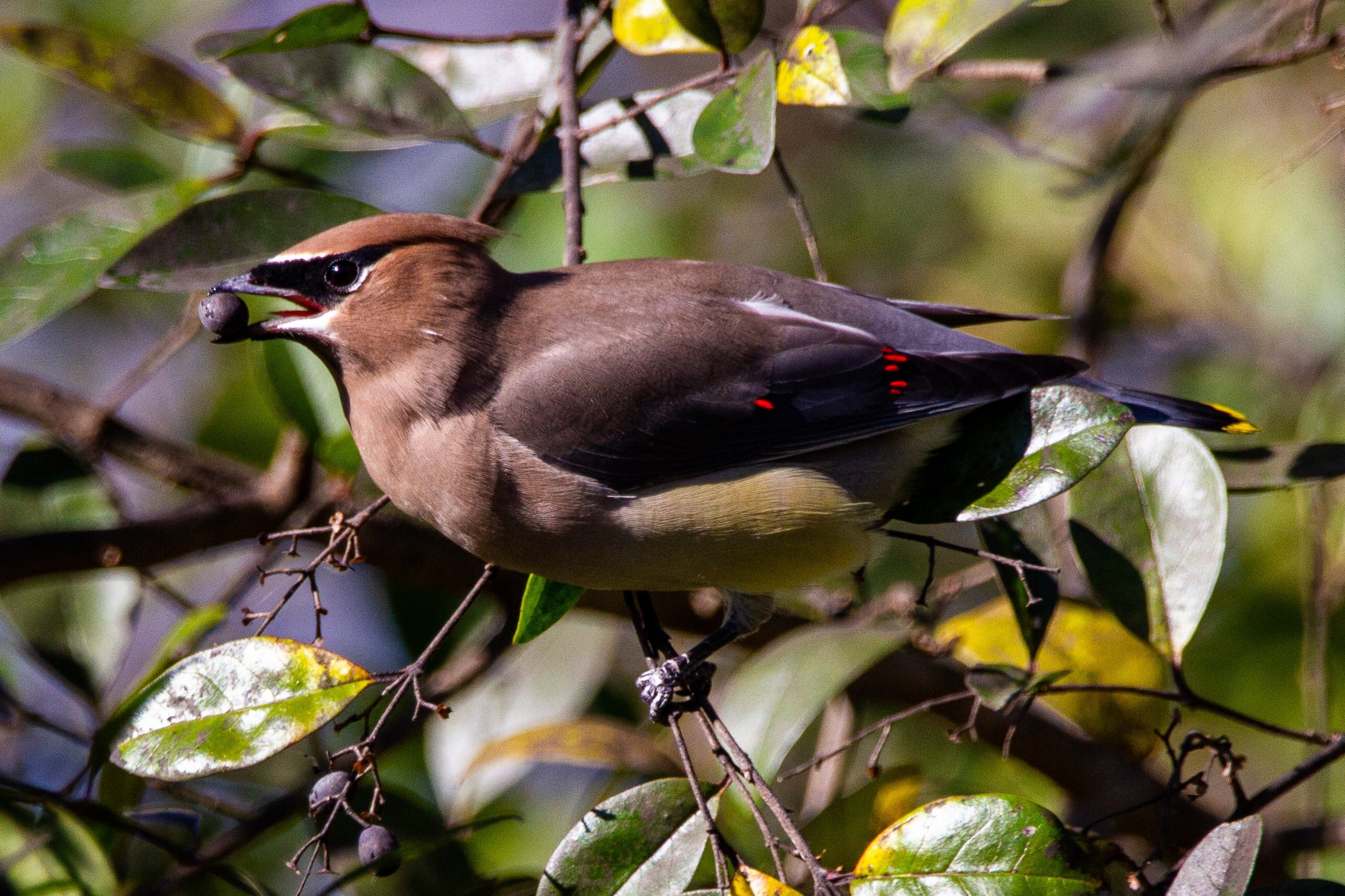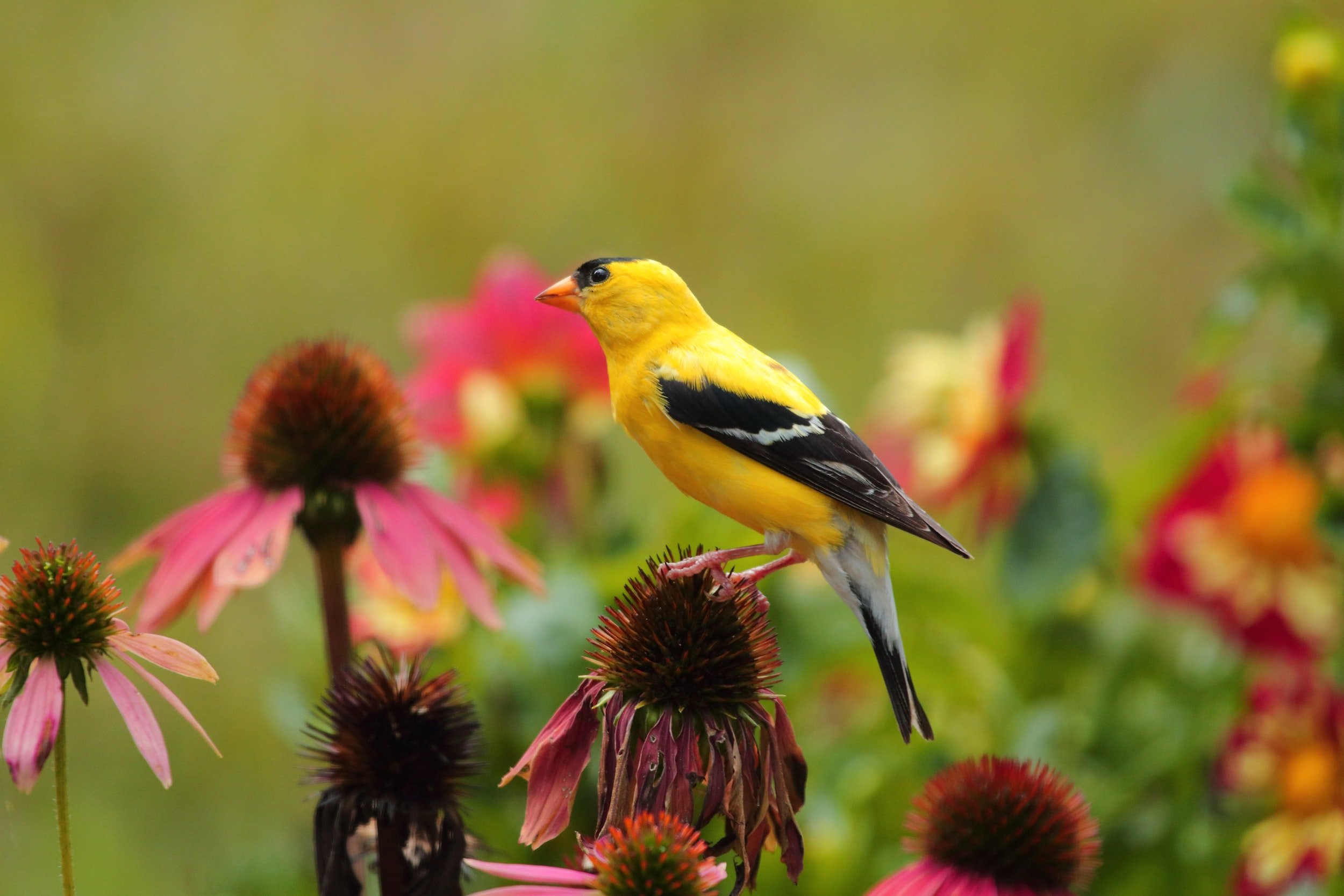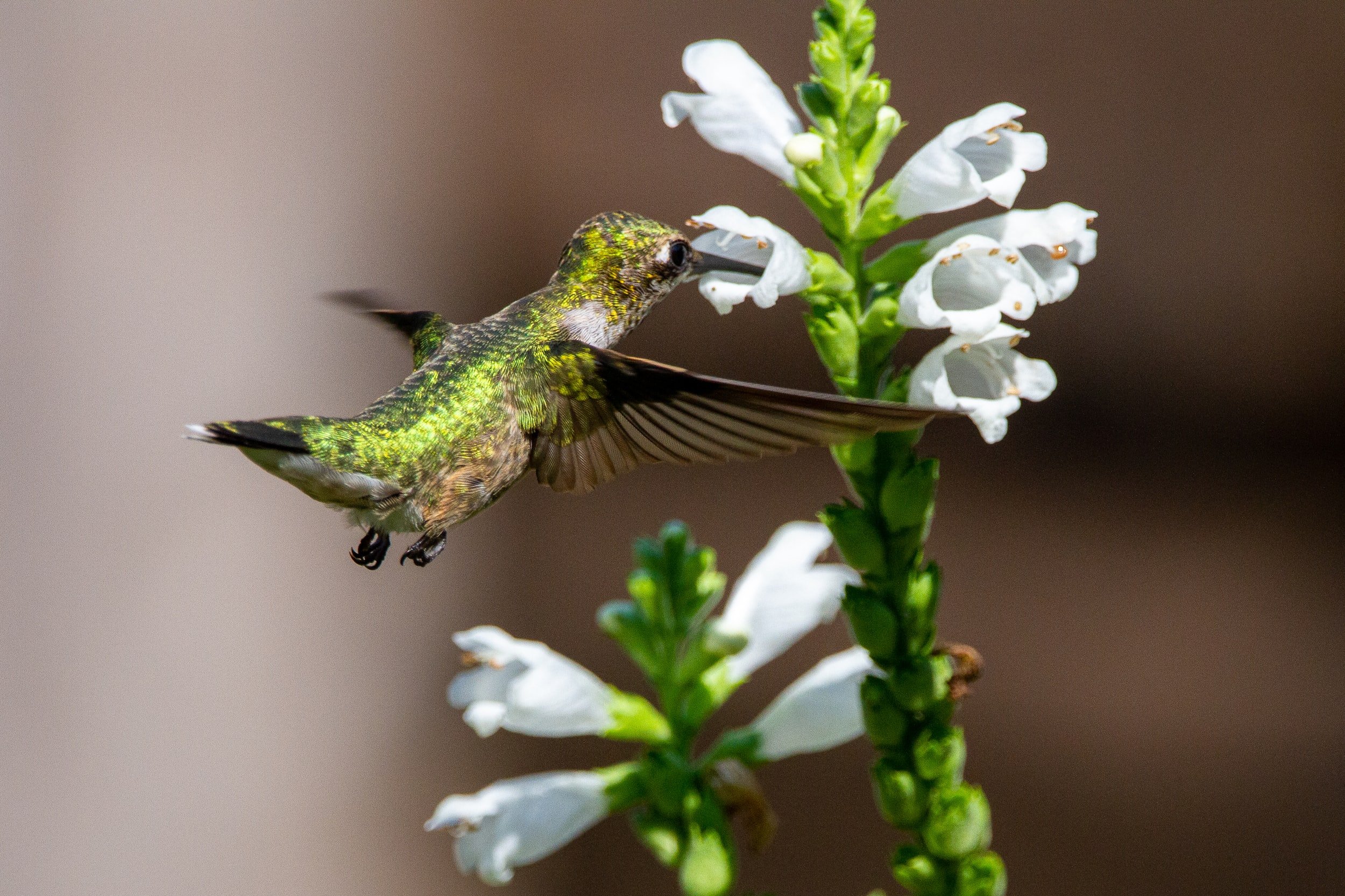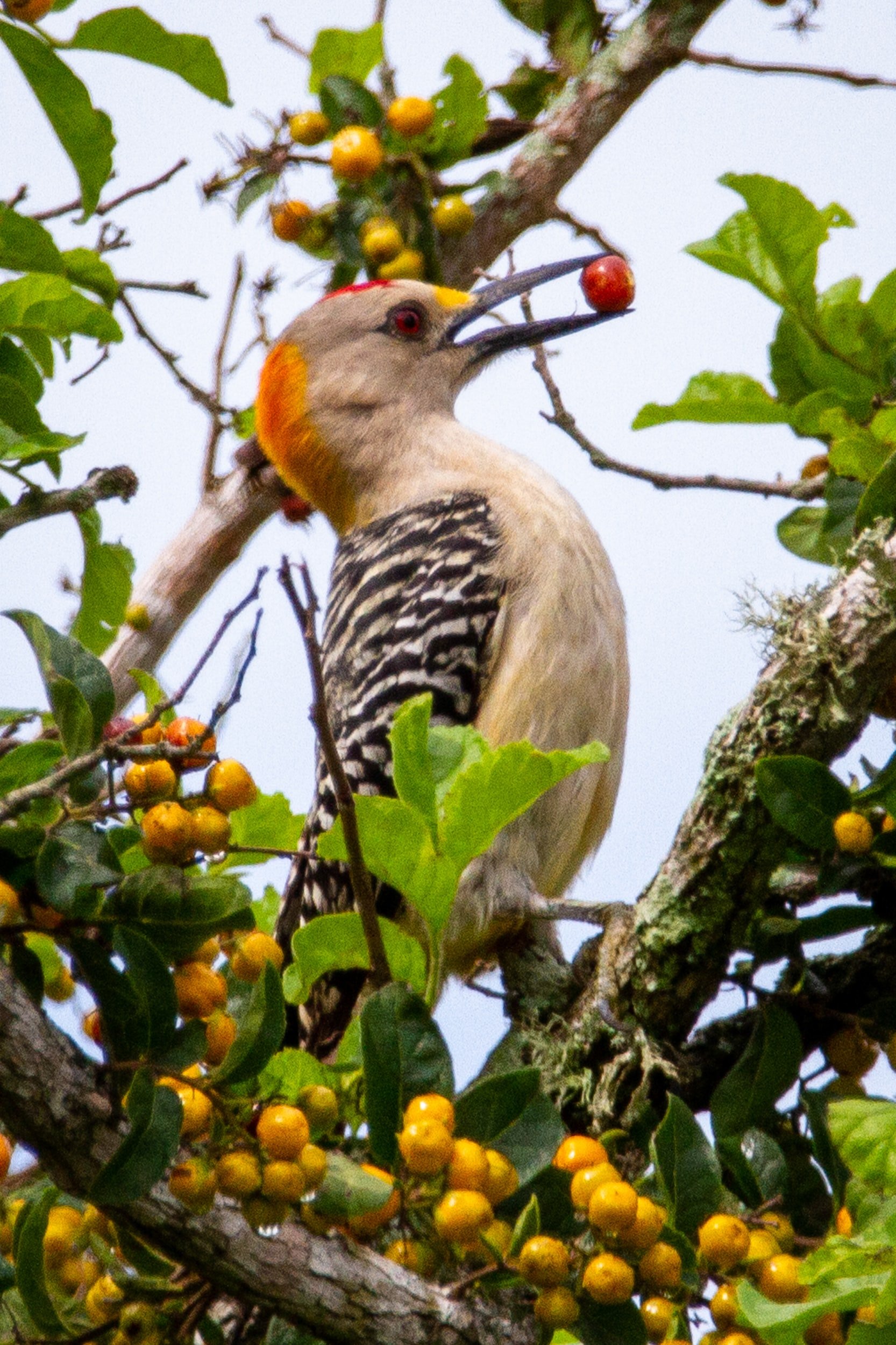Birds Need Native Plants to Survive
Much has been said lately about the importance of native plants for insects such as the beautiful Monarch butterfly, who require milkweed for their eggs; and bees, who need native plants for nesting and nectar, but did you know that birds need native plants too? Native plants are a critical, primary component of a bird’s habitat, supplying birds with food, shelter, and nesting for raising their young, for both migrating and non-migrating (resident) birds.
Native plants are any plant that occurs naturally in an area that was not introduced originally by humans from another area. Non-native plants were generally brought over from Europe or Asia for ornamental or other purposes. Non-native plants include the most common plants in urban and suburban areas such as grass for lawns, hostas, and daylilies. Non-native plants can crowd out native plants because they often bloom earlier or grow faster.
Native birds evolved alongside native plants in a harmonious way, where plants provide birds with the food and/or shelter they need, and birds help plants by spreading their seeds and eating insects that may harm them. Native plants provide birds with ideal nutrition throughout their life cycle: nectar and insects in the spring and summer, when they need protein to raise their young, and seeds in the fall when they need dense carbohydrates for their migration journeys. At their best, non-native plants simply provide little to no value to birds compared to native plants. At their worst, non-native plants can be aggressive and take over native plants, essentially killing them.
Bird Population Declines Due to Habitat Loss
As detailed in this series’ first post, bird populations in North America have suffered a tremendous decline in the past generation; there’s nearly 30% fewer birds now than there were since the 1970s. That’s about 3 billion birds in 50 years, according to the Cornell Lab of Ornithology. We’ve lost large amounts of many popular species, including several favorite backyard birds, such as blue jays (1 in 4 lost), red-winged blackbirds (1 in 3 lost), and dark-eyed juncos (1 in 3 lost).
The lack of natural habitat, including native plants, has been a significant contributing factor to the severe decline in bird populations. 50 years ago there was much more native habitat in areas that have since been developed for industrialized agriculture, housing, and industry.
When thinking about bird habitat, and the importance of providing native plants, it helps to consider 2 general categories of birds: full-time residents, and birds that migrate. Birds migrate to find food and to raise their families, and about half of all birds in North America migrate. Migrating birds spend nearly half their lives migrating, to find more food and to raise their families: In Illinois, in the spring, most migrants come from wintering grounds in the south, and stay for the summer to breed and raise families, such as baltimore orioles, red-winged blackbirds, and American robins (although some robins are full-time residents). In the fall, we welcome visitors from the north who spend their summers breeding in the northern boreal forests such as dark-eyed juncos and black-capped chickadees. Additionally, in both seasons, many migrating birds are just passing through but need food and shelter on their long journeys north and south. Full-time resident birds such as cardinals and mourning doves are able to find sufficient food and shelter throughout the year, without the need to migrate.
Migrating is hard work! Imagine flying constantly for several days, exhausted and ready to rest and eat, but all you see are corn fields everywhere, with not an insect or berry in sight. That’s the plight of many migrating birds flying over Illinois, where 75% of natural habitat has been transformed for agricultural purposes. Or they may fly over an urban or suburban area and see nothing but lawns and non-native trees and shrubs. Lawns - mostly in the form of non-native turf grass - covers more than 40 million acres of land in the United States, according to Doug Tallamy in Nature’s Best Hope: A New Approach to Conservation Thats Starts in Your Yard. 40 million acres is roughly the size of New England, and we are adding 500 square miles of lawn to the US every year (Kolbert 2008). Most lawns are treated with chemicals and so they provide no value to birds: there’s simply no food for a bird in a lawn; untreated lawns are only slightly better in that earthworms and dandelions provide some sustenance to some birds.
Aerial image of farmland: If you’ve ever flown over Illinois, it’s easy to see how little natural habitat is left for birds (photo: Unsplash)
Hope in Your Yards, Patios and Windowboxes
Though it seems surprising, the Chicago area provides critical habitat for many birds, both migrants and full-time residents. With so much of Illinois devoted to agriculture, the most populous areas, including Cook County, have a higher rate of natural areas, mainly parks, forest preserves and the lakefront. Migrating birds are attracted to these green areas, which is one reason why Chicago has such great birding for an urban area.
If you have a yard, or even an outdoor balcony or patio, you can help expand this green area and help birds tremendously – both migrants and full time residents - by planting native plants to provide birds with food, shelter and nesting throughout the year.
Birds evolved with specific native plants growing naturally all around them, providing them with the nutrients they need - insects, berries, seeds, flowers, or pollen. Native plants evolved to provide just the right nutrition when needed for a bird's life stage. Did you know that 98% of land-based birds feed their young insects? Insects are a great protein for growing young birds. Chickadee parents need about 9,000 caterpillars to feed one brood of chicks. Research by entomologist Doug Tallamy shows that a native oak tree can support 500 species of caterpillars, whereas ginkgos, a commonly planted landscape tree from Asia, host only 5 species of caterpillars. The value of native oaks for birds is clear; they provide required food abundantly. In the fall and winter, native plants provide berries and seeds that help birds on their long migration journeys and through cold and snowy winters. Native plants also provide birds with nesting materials: twigs for robins and cardinals, moss and lichen for hummingbirds, for example. Read more in Why Native Plants Are Better For Birds and People from Audubon.
Native Plants Feed Birds from HomegrownNationalPark.org
Getting Started
Although it may seem challenging at first, growing native plants is rewarding on many levels: you get to enjoy the beautiful plants, and you get to enjoy watching the birds (and insects and butterflies) that thrive on them! And it’s easier in the long run, as most native plants come back year after year, and they require less maintenance like watering and pruning, which gives you more time to bird!
You can plant natives gradually, alongside non-natives. Even just a few native plants can be beneficial. And if space is limited, you can use native plants in window boxes or containers.
Getting Started with a Native Garden from West Cook Wild Ones and Native Plant Gardening for Birds from Chicago Audubon have recommendations for a variety of sunny or shady locations. Grow These Native Plants So Your Backyard Birds Can Feast from Audubon has some good recommendations too.
There’s so many choices of beautiful natives. Here are some of my favorite easy native plants that generally work in some sun or partial shade areas:
Purple Coneflower - Goldfinches love these, especially in the fall
Bee Balm - Hummingbirds can’t resist the flowers for their nectar, and in the fall, finches, sparrows, juncos, and redpolls love to eat the seeds.
Great Blue Lobelia - another hummingbird favorite.
Black-eyed Susan - Goldfinches, chickadees, cardinals, white-breasted nuthatches, and sparrows love their seeds.
Wild Columbine - A spring favorite for newly arrived hummingbirds thirsty for nectar
Asters - There are so many different kinds of asters for fall blooms, including aromatic asters. American goldfinch, black-capped chickadee, blue jay, dark-eyed junco, eastern towhee, northern cardinal, and white-breasted nuthatch love them.
Bottlebrush grass - all kinds of native sparrows love the seeds of these and other native grasses and sedges.
Although I’ve chosen these for their direct attraction to birds, keep in mind that many native plants are more important because they host insects that birds need to eat and feed their young. And while you may start with flowering plants and grasses, you’ll want to include shrubs and trees too.
Finding native plants is getting easier, as the word is spreading about their many benefits to birds, insects and humans. It’s usually best to get natives from local nurseries or related organizations.
Here are some resources to get you started.
Guide to local native landscapers and nurseries - West Cook Wild Ones
Where to Buy Native Plants from Chicago Bungalow Association - it’s from 2022, but provides links to many organizations that sell natives and we’ll update it when the 2023 list is published.
Illinois Native Plant Sales - Illinois Native Plant Society
Most big box stores are starting to sell natives too, although there are concerns about their use of chemicals. Check the labels and avoid any that are labeled “cultivars”, as these are hybridized natives that may not have all the benefits a native offers.
Maintaining a native garden is best done with minimal clean-up - in other words, “leave the leaves”. The typical cleanup of American lawns has become extreme, with leaf blowers eliminating many of the “leftovers” birds love. Fallen leaves can contain larvae and insects, dried flower heads are filled with nutritious seeds. Clear your pathways by pushing dried leaves and stems into your garden beds - they make good mulch for your plants and the birds can forage all year long.
If you need additional motivation, consider that planting natives in your yard could contribute to a “Homegrown National Park,” a grass-roots project to repurpose half of America’s lawnscape for ecologically productive use, started by entomologist, ecologist and author Doug Tallamy. If half of all American lawns were planted with native plants, it would comprise more than 20 million acres, the equivalent of nearly ten Yellowstones.
Planting native plants is a fun way to help birds, and you will likely notice new birds in your garden in the first year. It’s very gratifying to see a hummingbird enjoying bee balm, or a White-crowned sparrow foraging insects and seeds under a clump of asters. Learn more about the benefits of native planting and you’ll get hooked on this “new” way of providing birds and insects with the food and habitat they need to survive and thrive.
Learn More
3 billion fewer birds than we had in 1970: Birds are disappearing at alarming rates in Illinois and across North America, new science reveals - Chicago Tribune
Native Plants Database - National Audubon Society
Native Plant Gardening for Birds - Chicago Audubon Society
Why Native Plants Matter - National Audubon Society
Guide to Native Gardening - West Cook Wild Ones
Native plant window boxes: calling apartment and townhome dwellers! - Nuts for Natives
4% of Illinois Land Is Protected. The Goal Is To Conserve 30% by 2030. How? - WTTW
Meet The Ecologist Who Wants You to Unleash the Wild on Your Backyard - Smithsonian Magazine
Bringing Nature Home - How You Can Sustain Wildlife with Native Plants, - Douglas W. Tallamy, Rick Darke
The Living Landscape - Designing for Beauty and Biodiversity in the Home Garden - Rick Darke, Douglas W. Tallamy
Nature’s Best Hope: A New Approach to Conservation Thats Starts in Your Yard - Doug Tallamy
Unless otherwise specified, all photos: Unsplash; header graphic: Judy Cheske

















